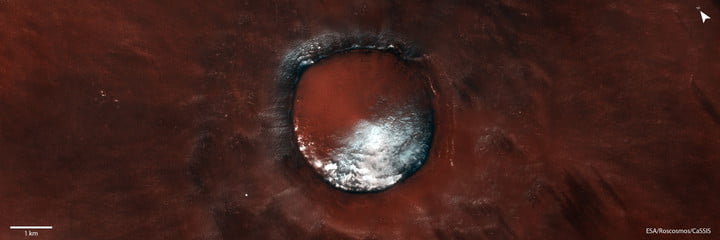See an Icy Crater on Mars Captured by Trace Gas Orbiter
The European Space Agency (ESA) has released a stunning new image of an icy crater on Mars, taken by the Trace Gas Orbiter. The Trace Gas Orbiter, a collaboration between ESA and Russian space agency Roscosmos, primarily examines the gases in the martian atmosphere but also takes images of the surface and acts as a communication link between landers and rovers on the surface and Earth.
This striking image shows a crater 2.5 miles wide near Mars’s northern pole, in the Vastitas Borealis region:

The color differences show the red Martian soil contrasted with water ice inside the crater.
“The crater is partially filled with water ice, which is also particularly predominant on its north-facing slopes that receive fewer hours of sunlight on average throughout the year,” ESA writes. “The dark material clearly visible on the crater rim – giving it a somewhat scorched appearance – likely consists of volcanic materials such as basalt.
“Most of the surrounding terrain is ice free, but has been shaped by ongoing aeolian processes. The streaks at the bottom right of the image are formed by winds that have removed the brighter iron oxide dust from the surface, exposing a slightly darker underlying substrate.”
Finding water on Mars is a big challenge for potential crewed missions there, as water is too heavy to carry all the way to Mars on a rocket. One option for future explorers is to find craters on the planet that contain water ice, like this one or the famous Korolev crater, which could be melted down and used for drinking and for fuel. However, most places where there is ice on the surface of Mars are around the poles, and most missions want to visit the equatorial regions.
Another option is to look beneath the surface for ice, which is the plan of upcoming missions like the Mars Ice Mapper. A final option would be to take hydrated minerals from the soil and bake them to release the water they contain.




